Keywords: marginalizing over discretes | mixture model | gaussian mixture model | log-sum-exp trick | pymc3 | Download Notebook
Contents
- Class Model for 3 gaussian mixture
- The log-sum-exp trick and mixtures
- Pymc3 implements the log-sum-exp directly
- Posterior Predictive
- By Hand
%matplotlib inline
import numpy as np
import scipy as sp
import matplotlib as mpl
import matplotlib.cm as cm
import matplotlib.pyplot as plt
import pandas as pd
pd.set_option('display.width', 500)
pd.set_option('display.max_columns', 100)
pd.set_option('display.notebook_repr_html', True)
import seaborn as sns
sns.set_style("whitegrid")
sns.set_context("poster")
import pymc3 as pm
import theano.tensor as tt
data=np.loadtxt("data/3g.dat")
data.shape
(1000,)
Class Model for 3 gaussian mixture
with pm.Model() as mof2:
p = pm.Dirichlet('p', a=np.array([1., 1., 1.]), shape=3)
# ensure all clusters have some points
p_min_potential = pm.Potential('p_min_potential', tt.switch(tt.min(p) < .1, -np.inf, 0))
# cluster centers
means = pm.Normal('means', mu=[0, 10, 20], sd=5, shape=3)
order_means_potential = pm.Potential('order_means_potential',
tt.switch(means[1]-means[0] < 0, -np.inf, 0)
+ tt.switch(means[2]-means[1] < 0, -np.inf, 0))
# measurement error
sds = pm.Uniform('sds', lower=0, upper=20, shape=3)
# latent cluster of each observation
category = pm.Categorical('category',
p=p,
shape=data.shape[0])
# likelihood for each observed value
points = pm.Normal('obs',
mu=means[category],
sd=sds[category],
observed=data)
The log-sum-exp trick and mixtures
From the Stan Manual:
The log sum of exponentials function is used to define mixtures on the log scale. It is defined for two inputs by
If a and b are probabilities on the log scale, then $exp(a) + exp(b)$ is their sum on the linear scale, and the outer log converts the result back to the log scale; to summarize, log_sum_exp does linear addition on the log scale. The reason to use the built-in log_sum_exp function is that it can prevent underflow and overflow in the exponentiation, by calculating the result as
where c = max(a, b). In this evaluation, one of the terms, a − c or b − c, is zero and the other is negative, thus eliminating the possibility of overflow or underflow in the leading term and eking the most arithmetic precision possible out of the operation.
As one can see below, pymc3 uses the same definition
From https://github.com/pymc-devs/pymc3/blob/master/pymc3/math.py#L27
def logsumexp(x, axis=None):
# Adapted from https://github.com/Theano/Theano/issues/1563
x_max = tt.max(x, axis=axis, keepdims=True)
return tt.log(tt.sum(tt.exp(x - x_max), axis=axis, keepdims=True)) + x_max
For example (as taken from the Stan Manual), the mixture of $N(−1, 2)$ and $N(3, 1)$ with mixing proportion $\lambda = (0.3, 0.7)$:
where log_sum_exp is the function as defined above.
This generalizes to the case of more mixture components.
This is thus a custon distribution logp we must define. If we do this, we can go directly from the Dirichlet priors for $p$ and forget the category variable
Pymc3 implements the log-sum-exp directly
Lets see the source here to see how its done:
https://github.com/pymc-devs/pymc3/blob/master/pymc3/distributions/mixture.py
There is a marginalized Gaussian Mixture model available, as well as a general mixture. We’ll use the NormalMixture, to which we must provide mixing weights and components.
with pm.Model() as mof3:
p = pm.Dirichlet('p', a=np.array([1., 1., 1.]), shape=3)
# ensure all clusters have some points
p_min_potential = pm.Potential('p_min_potential', tt.switch(tt.min(p) < .1, -np.inf, 0))
means = pm.Normal('means', mu=[0, 20, 40], sd=5, shape=3)
order_means_potential = pm.Potential('order_means_potential',
tt.switch(means[1]-means[0] < 0, -np.inf, 0)
+ tt.switch(means[2]-means[1] < 0, -np.inf, 0))
# measurement error
sds = pm.Uniform('sds', lower=0, upper=20, shape=3)
points = pm.NormalMixture('obs', p, mu=means, sd=sds, observed=data)
INFO (theano.gof.compilelock): Refreshing lock /Users/rahul/.theano/compiledir_Darwin-16.1.0-x86_64-i386-64bit-i386-3.6.1-64/lock_dir/lock
with mof3:
tripletrace_full3 = pm.sample(10000, tune=2000)
Auto-assigning NUTS sampler...
Initializing NUTS using jitter+adapt_diag...
Multiprocess sampling (2 chains in 2 jobs)
NUTS: [sds_interval__, means, p_stickbreaking__]
95%|█████████▌| 11458/12000 [01:00<00:02, 190.34it/s]INFO (theano.gof.compilelock): Refreshing lock /Users/rahul/.theano/compiledir_Darwin-16.1.0-x86_64-i386-64bit-i386-3.6.1-64/lock_dir/lock
100%|██████████| 12000/12000 [01:02<00:00, 191.03it/s]
pm.traceplot(tripletrace_full3);
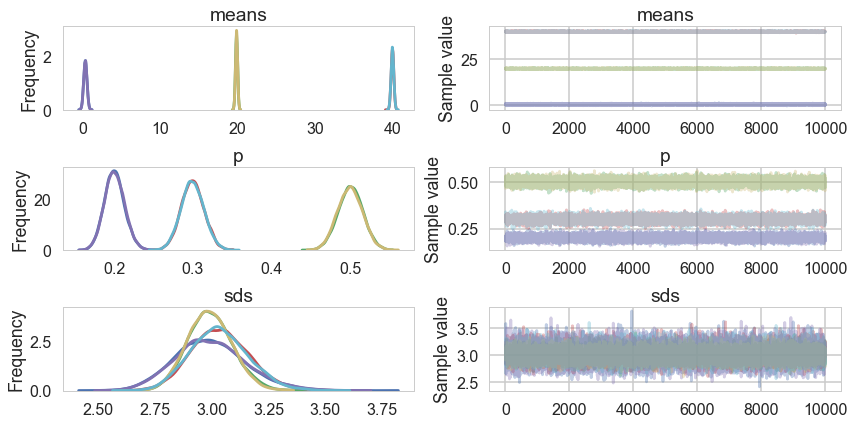
pm.autocorrplot(tripletrace_full3);
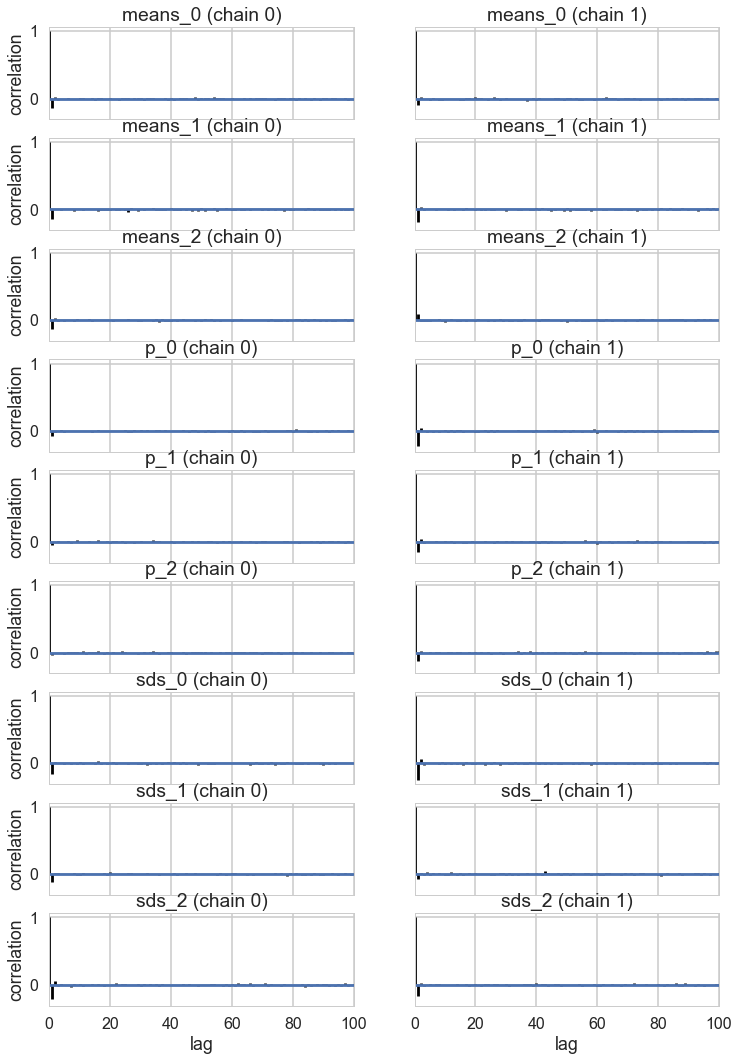
pm.plot_posterior(tripletrace_full3);
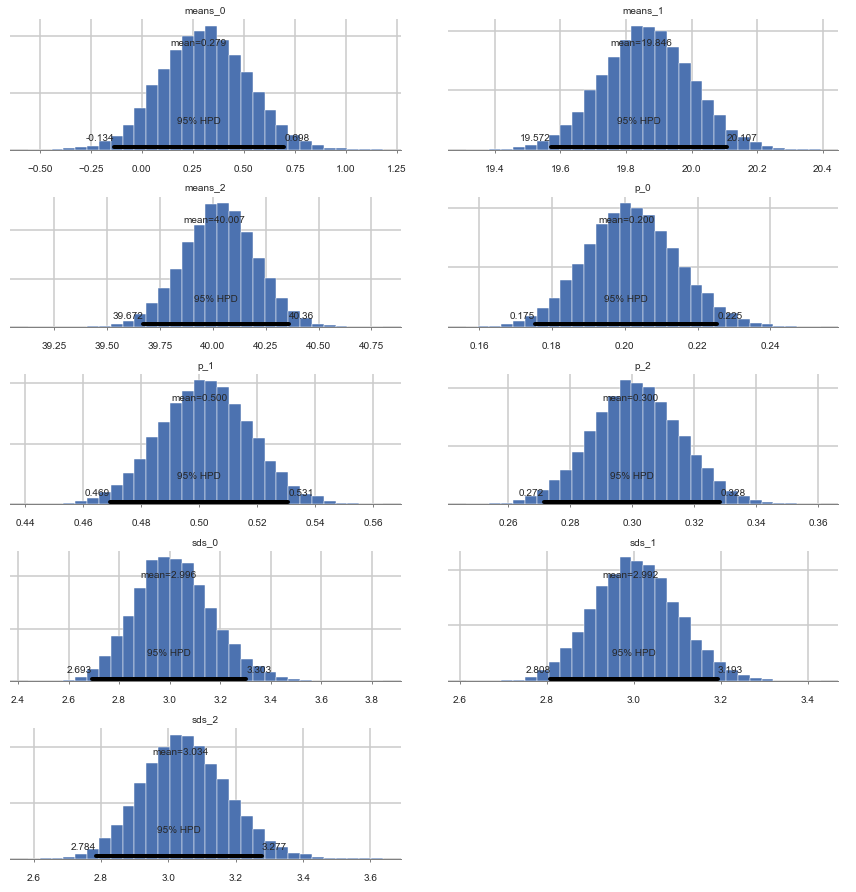
Posterior Predictive
with mof3:
ppc_trace = pm.sample_ppc(tripletrace_full3, 5000)
0%| | 0/5000 [00:00<?, ?it/s]INFO (theano.gof.compilelock): Refreshing lock /Users/rahul/.theano/compiledir_Darwin-16.1.0-x86_64-i386-64bit-i386-3.6.1-64/lock_dir/lock
100%|██████████| 5000/5000 [00:04<00:00, 1064.44it/s]
plt.hist(data, bins=30, normed=True,
histtype='step', lw=2,
label='Observed data');
plt.hist(ppc_trace['obs'], bins=30, normed=True,
histtype='step', lw=2,
label='Posterior predictive distribution');
plt.legend(loc=1);
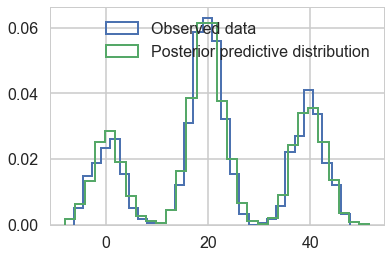
You can see the general agreement between these two distributions in this posterior predictive check!
By Hand
We need to write out the logp for the likelihood ourself now, using logsumexp to do the sum we need.
from pymc3.math import logsumexp
def logp_normal(mu, sigma, value):
# log probability of individual samples
delta = lambda mu: value - mu
return (-1 / 2.) * (tt.log(2 * np.pi) + tt.log(sigma*sigma) +
(delta(mu)* delta(mu))/(sigma*sigma))
# Log likelihood of Gaussian mixture distribution
def logp_gmix(mus, pis, sigmas, n_samples, n_components):
def logp_(value):
logps = [tt.log(pis[i]) + logp_normal(means[i], sigmas[i], value)
for i in range(n_components)]
return tt.sum(logsumexp(tt.stacklists(logps)[:, :n_samples], axis=0))
return logp_
with pm.Model() as mof2:
p = pm.Dirichlet('p', a=np.array([1., 1., 1.]), shape=3)
# ensure all clusters have some points
p_min_potential = pm.Potential('p_min_potential', tt.switch(tt.min(p) < .1, -np.inf, 0))
# cluster centers
means = pm.Normal('means', mu=[0, 10, 20], sd=5, shape=3)
order_means_potential = pm.Potential('order_means_potential',
tt.switch(means[1]-means[0] < 0, -np.inf, 0)
+ tt.switch(means[2]-means[1] < 0, -np.inf, 0))
# measurement error
sds = pm.Uniform('sds', lower=0, upper=20, shape=3)
# latent cluster of each observation
# category = pm.Categorical('category',
# p=p,
# shape=data.shape[0])
# likelihood for each observed valueDensityDist('x', logp_gmix(mus, pi, np.eye(2)), observed=data)
points = pm.DensityDist('obs', logp_gmix(means, p, sds, data.shape[0], 3),
observed=data)
INFO (theano.gof.compilelock): Refreshing lock /Users/rahul/.theano/compiledir_Darwin-16.1.0-x86_64-i386-64bit-i386-3.6.1-64/lock_dir/lock
with mof2:
tripletrace_full2 = pm.sample(10000, tune=2000, njobs=1)
Auto-assigning NUTS sampler...
Initializing NUTS using jitter+adapt_diag...
Sequential sampling (2 chains in 1 job)
NUTS: [sds_interval__, means, p_stickbreaking__]
100%|██████████| 12000/12000 [00:55<00:00, 217.35it/s]
100%|██████████| 12000/12000 [00:38<00:00, 310.05it/s]
pm.traceplot(tripletrace_full2);
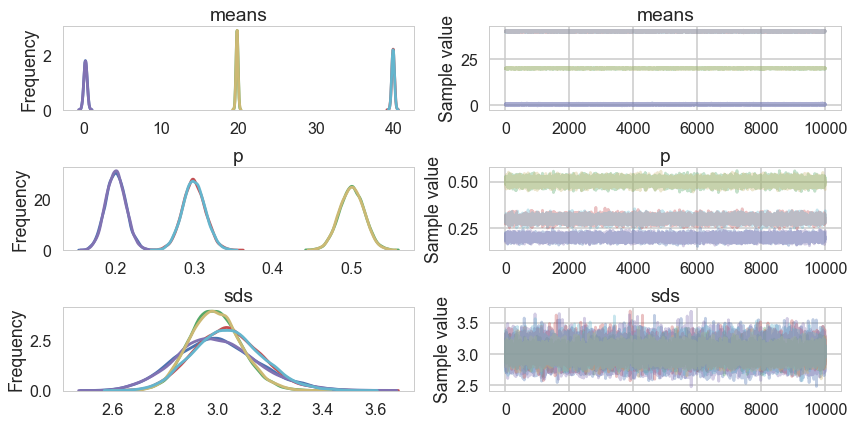
tripletrace_full2[0]
{'means': array([ -2.63567074e-02, 1.97651323e+01, 4.00719437e+01]),
'p': array([ 0.21479503, 0.49260884, 0.29259613]),
'p_stickbreaking__': array([-0.60311337, 0.52092218]),
'sds': array([ 2.95977013, 2.88030396, 3.12347716]),
'sds_interval__': array([-1.75046541, -1.78233378, -1.68697662])}
Posterior predictive
You cant use sample_ppc directly because we did not create a sampling function for our DensityDist. But this is easy to do for a mixture model. Sample a categorical from the p’s above, and then sample the appropriate gaussian.
Exercise: Write a function to do this!
with mof2:
ppc_trace2 = pm.sample_ppc(tripletrace_full2, 5000)
0%| | 0/5000 [00:00<?, ?it/s]
---------------------------------------------------------------------------
AttributeError Traceback (most recent call last)
<ipython-input-32-bc8d116a4478> in <module>()
1 with mof2:
----> 2 ppc_trace2 = pm.sample_ppc(tripletrace_full2, 5000)
//anaconda/envs/py3l/lib/python3.6/site-packages/pymc3/sampling.py in sample_ppc(trace, samples, model, vars, size, random_seed, progressbar)
1028
1029 for var in vars:
-> 1030 ppc[var.name].append(var.distribution.random(point=param,
1031 size=size))
1032
AttributeError: 'DensityDist' object has no attribute 'random'